In an era where technology permeates every aspect of our lives, understanding the fundamentals of electricity is more crucial than ever. This invisible force powers our world, from the smallest gadget in our pockets to the largest cities on our planet. Introducing children to the marvels of electricity through electricity science experiments for kids is not just an educational endeavor; it’s a journey into the heart of curiosity and innovation. This article serves as a vibrant gateway for young minds to explore and grasp the principles of electricity, circuits, and electromagnetism in an engaging and hands-on manner.
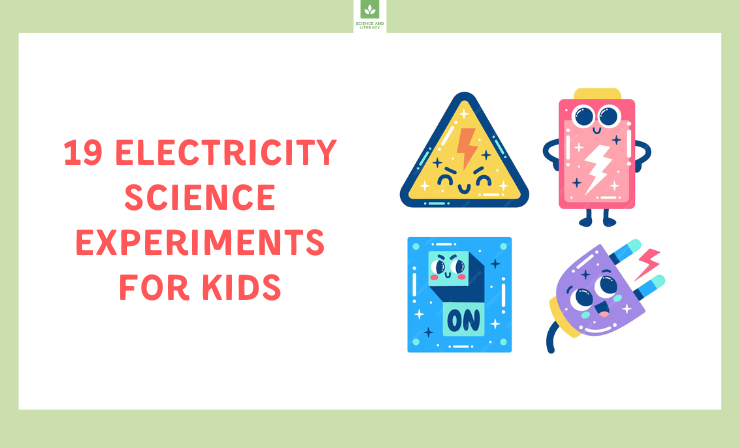
These experiments, tailored for children, transform complex scientific concepts into accessible and enjoyable activities, fostering a deep and lasting interest in science, technology, engineering, and mathematics (STEM). Beyond mere academic learning, these activities equip children with critical thinking skills, creativity, and a problem-solving mindset—abilities essential for navigating the challenges of the 21st century. As kids light up LEDs, power clocks with fruits, or create simple motors, they’re not just performing tasks; they’re embarking on a voyage of discovery, understanding the science that shapes our world.
Looking for some fun, educational activities to try with the kids? This article shares some great science experiments that teach children all about electricity. https://t.co/wRk6qoemUi pic.twitter.com/WaZGNRTeT2
— AnstandigElectric (@AnstandigE) April 25, 2022
Moreover, it underscores the importance of experiential learning. By engaging directly with scientific phenomena, children move beyond passive absorption of information to active creation of knowledge. This article, therefore, is more than just a collection of experiments; it’s a blueprint for inspiring the next generation of scientists, engineers, and innovators. It demonstrates that with a bit of curiosity and creativity, the mysteries of electricity can illuminate young minds, sparking a lifelong passion for learning and exploration.
On this page, you will discover:
- 19 Experiments for Kids →
- The Value of Electricity Science Experiments for Kids →
- Questions For Further Exploration →
As we delve into the heart of our article, the following section serves as a bridge to the practical application of the theories and principles discussed earlier. Here, we transition from theory to practice, offering young explorers a hands-on opportunity to witness the magic of electricity and magnetism. So, let’s embark on this practical exploration together, turning curiosity into knowledge and imagination into discovery.
| Experiment | Difficulty level | Cost | Description |
| 1. Bending Water with Static Electricity | Low | Low ($1 to $5) | Discover how static electricity can divert a stream of water, demonstrating invisible electric forces at play. |
| 2. Make a Magic Wand | Low | Low ($1 to $5) | Learn how to attract lightweight objects with a “magic wand” charged through the power of static electricity. |
| 3. Bubble Balloons | Low | Low ($1 to $5) | Observe how a statically charged balloon can attract and manipulate bubble balloons without popping them. |
| 4. Soda Can Electroscope | Low | Low ($1 to $5) | Detect static electricity with a soda can, visualizing how charged objects can move without being touched. |
| 5. Separate Salt & Pepper | Low | Low ($1 to $5) | Use static electricity to separate a mix of salt and pepper, showcasing the different behaviors of materials under electrostatic influence. |
| 6. Butterfly Experiment | Low | Low ($1 to $5) | Simulate the fluttering of a butterfly using static electricity, merging science with creativity. |
| 7. Homopolar Motor | Low | Low ($1 to $5) | Create a spinning motor using only a battery, a magnet, and a wire to demonstrate fundamental electromagnetism. |
| 8. Electric Cornstarch | Low | Low ($1 to $5) | Witness how a mixture of cornstarch and oil responds to static electricity, demonstrating non-traditional material conductivity. |
| 9. Simple Lemon Battery | Low | Low ($1 to $5) | Generate electricity with a lemon to power a small device, illustrating basic electrochemical energy conversion. |
| 10. Index Card Flashlight Experiment | Middle | Low ($1 to $5) | Illuminate a light bulb using simple materials to create a basic circuit, highlighting the principles of electrical connectivity. |
| 11. Potato Clock | Middle | Low ($1 to $5) | Turn a potato into an energy source for a digital clock, exploring the chemical reactions that generate electricity. |
| 12. Water & Electricity | Middle | Low ($1 to $5) | Compare how saltwater and vinegar conduct electricity differently, emphasizing the role of electrolytes. |
| 13. Create a Motor | Middle | Middle ($5 to $10) | Assemble a simple motor to understand the interaction between electricity and magnetism in creating motion. |
| 14. Build a Power Pack | Middle | Middle ($5 to $10) | Craft a basic power source to learn how electricity flows through circuits to power devices. |
| 15. Making a Dimmer Switch | Middle | Middle ($5 to $10) | Experiment with controlling the brightness of a light bulb, introducing the concept of electrical resistance in circuits. |
| 16. Paper Circuits | Middle | Middle ($5 to $10) | Combine art and science by creating functional electrical circuits on paper with conductive tape and LEDs. |
| 17. Play-Dough Circuits | Middle | Middle ($5 to $10) | Use conductive and insulating play dough to form simple circuits, introducing the basics of electricity flow and circuit design. |
| 18. Build an Electromagnetic Train | High | Middle ($5 to $10) | Explore electromagnetic propulsion by building a mini-train that moves along a track without physical contact. |
| 19. Bottle Radio | High | High ($10 to $20) | Construct a rudimentary radio receiver using a bottle and aluminum foil to capture and translate radio waves into sound. |
1. Bending Water with Static Electricity
This experiment demonstrates the interaction between static electricity and a thin stream of water, vividly illustrating how a charged object can manipulate the flow path of water. By engaging in this activity, participants see firsthand the invisible force of static electricity at work, affecting the physical world in surprising ways.
Difficulty Level: Low
Cost: Low ($1 to $5)

Materials
- A plastic comb or balloon
- A wool sweater or piece of fabric
- A sink with a faucet that can produce a thin stream of water
Steps
- Adjust the faucet to create a thin, steady stream of water.
- Rub the comb or balloon against the wool fabric for about 30 seconds to generate static electricity.
- Slowly bring the charged comb or balloon near the water stream without touching it.
- Observe how the water stream bends towards the comb or balloon, demonstrating the effect of the static electric field.
- Try varying distances and angles to explore how the strength of the electric field affects the water’s behavior.
Watching the video “How to Bend Running Water (using a Comb)” is recommended for an engaging demonstration in action.
What It Teaches
Learners gain insight into the concepts of electric charge and electric fields, understanding how charged objects can influence neutral ones in their vicinity. This experiment serves as a practical demonstration of the principles of electrostatics, including attraction, repulsion, and the behavior of electric fields.
Conceptual Background
This experiment showcases the principles of static electricity and electrostatic attraction. When certain materials are rubbed together, electrons are transferred from one material to the other, resulting in one object becoming negatively charged and the other positively charged.
Water molecules are polar, meaning they have a slight positive charge on one end and a slight negative charge on the other. When a charged object like a comb comes close, the charged comb attracts the opposite charges in the water molecules, causing the stream of water to bend towards the comb.
2. Make a Magic Wand
The experiment showcases the ability of static electricity to attract objects, effectively turning a simple rod into a ‘magic wand’. This visually engaging activity helps to demystify the concept of static electricity and demonstrates its practical effects.
Difficulty Level: Low
Cost: Low ($1 to $5)
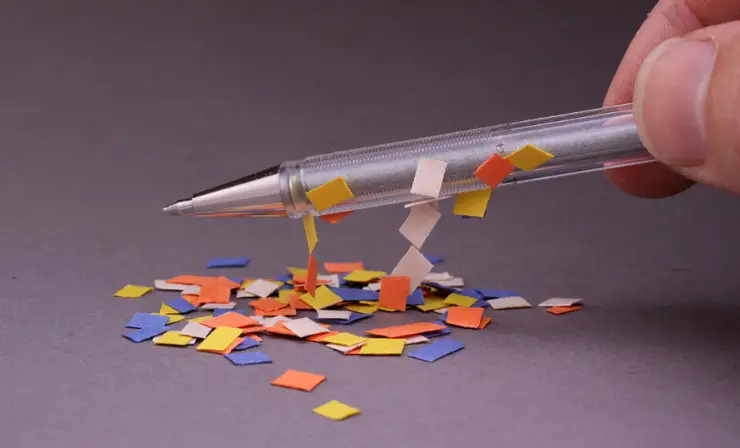
Materials
- A plastic rod or ruler
- A wool fabric
- Small, lightweight objects such as paper bits, confetti, or cereal
Steps
- Rub the plastic rod or ruler vigorously with the wool fabric to generate a static charge.
- Slowly approach the charged rod to the small objects laid out on a surface.
- Watch as the objects are attracted to the rod and stick to it, simulating the effect of a ‘magic wand’.
- Explore how different materials and objects react to the static charge, noting variations in attraction strength.
For an engaging demonstration of how a simple rod and piece of fabric can transform into a magic wand, watching the corresponding experiment video is recommended.
What It Teaches
Participants learn about static electricity, including how and why certain materials become charged and how those charges can attract neutral objects. The experiment introduces foundational concepts in physics, such as electric charge, electric fields, and the interaction between charged and neutral bodies. It also encourages curiosity about the natural world and the unseen forces that shape our daily experiences.
Conceptual Background
Static electricity is the result of the imbalance of electrons on the surface of materials. Rubbing the plastic rod with wool fabric transfers electrons between the two materials, charging the rod. Small lightweight objects like paper bits are easily influenced by static electric fields because they are light enough to be moved by the attractive force of the static charge.
3. Bubble Balloons
This experiment highlights how static electricity can affect the behavior of bubble balloons, offering a fun and interactive way to observe the effects of electrical charges on physical objects.
Difficulty Level: Low
Cost: Low ($1 to $5)
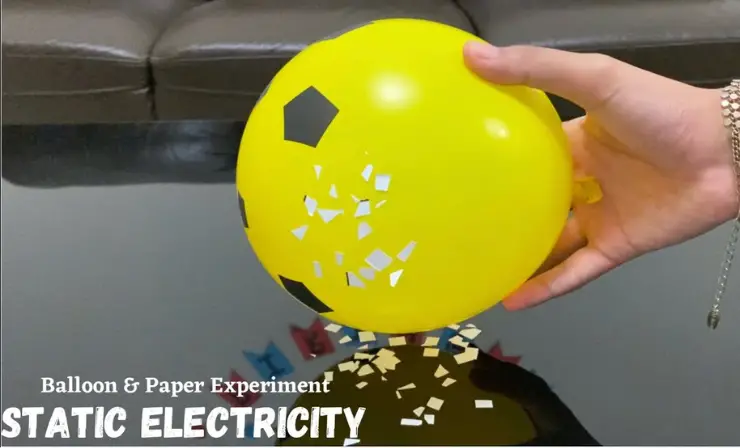
Materials
- A balloon
- Wool fabric
- Bubble solution
- A bubble wand or small loop of wire
Steps
- Inflate the balloon and generate a static charge by rubbing it against the wool fabric.
- Create a bubble using the bubble solution and wand.
- Approach the charged balloon to the bubble without touching it.
- Observe the attraction between the balloon and the bubble, showing the influence of static electricity.
- Try different distances and angles to explore the strength and range of the static electric field.
Watching the video is recommended to learn how to conduct the Bubble Balloons experiment and see the fascinating science in action.
What It Teaches
Learners gain insights into electrostatics, observing how electric charges can cause movement and changes in the state of materials. The experiment serves as a vivid illustration of how charged objects interact with other materials, showcasing induced charges and the principles of electrical attraction and repulsion.
Conceptual Background
Similar to the water bending experiment, this activity demonstrates static electricity and its effects on objects. The surface of the balloon, after being rubbed against hair or wool, becomes negatively charged. This static charge can attract the thin surface of a bubble without popping it because the forces of attraction are gentle and the bubble’s surface is flexible, demonstrating the principle of electrostatic forces on different materials.
4. Soda Can Electroscope
The Soda Can Electroscope experiment demonstrates how movement can be detected and visualized without direct contact, using principles of electrostatics. It aims to explore the basics of how electric charges can induce motion in everyday objects, providing a tangible demonstration of invisible forces at work.
Difficulty Level: Low
Cost: Low ($1 to $5)
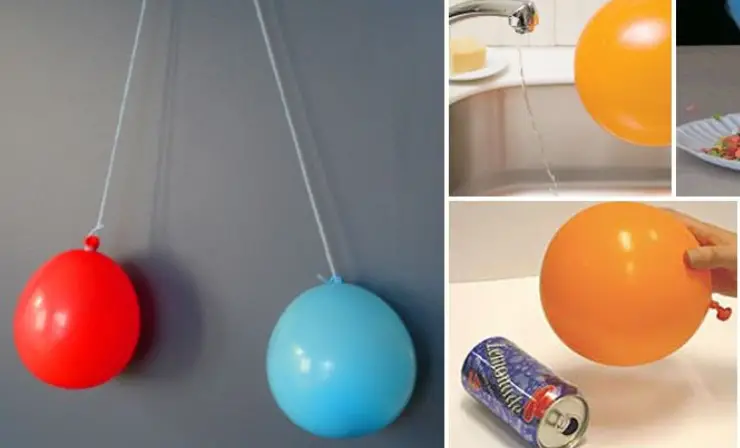
Materials
- An empty soda can
- A piece of wool fabric
- A balloon
- A flat surface (like a table)
Steps
- Place the soda can on its side on a flat surface.
- Inflate the balloon and then rub it vigorously against the wool fabric to generate static electricity.
- Slowly bring the charged balloon near the soda can without touching it.
- Observe how the can starts to roll towards the balloon, demonstrating the effect of the static electric field generated by the balloon.
- Try different distances and angles to see how the electric field’s strength and direction affect the movement of the can.
To discover how to conduct the Soda Can Electroscope experiment, it is recommended to watch this informative video.
What It Teaches
This experiment introduces learners to the concept of electrostatic forces and how they can cause motion in objects. It highlights the fundamental principles of electricity and magnetism, illustrating how charged objects interact with neutral ones. Participants will understand the basics of how an electroscope works, gaining insight into methods of detecting electric charges and the influence of electrostatic forces on materials.
Conceptual Background
An electroscope is a device used to detect electric charge. In this simple version, the soda can becomes a detector of static electricity. Rubbing the balloon transfers electrons to it, negatively charging the balloon. Bringing it close to the can induces a charge separation in the can, with electrons in the can repelled away from the balloon, causing the can to roll towards the balloon.
5. Separate Salt & Pepper
This experiment utilizes electrostatic principles to separate salt and pepper mixtures, illustrating how different materials respond to electric charges. It demonstrates the effect of static electricity on small particles and provides insight into the nature of electrical attraction and repulsion.
Difficulty Level: Low
Cost: Low ($1 to $5)
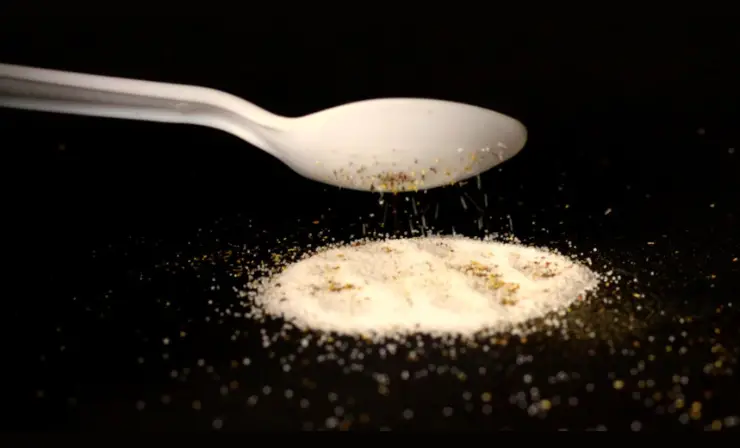
Materials
- A battery or a plastic spoon (optional)
- Salt
- Pepper
- Two separate containers
Steps
- Mix equal parts of salt and pepper in a container.
- Place the battery horizontally on a table, ensuring it remains stationary.
- Slowly sprinkle the salt and pepper mixture around one end of the battery.
- Observe how the particles move and separate in response to the electric field generated by the battery.
- Discuss the results and the principles of static electricity that cause the salt and pepper to behave differently.
To see a practical demonstration of how to separate salt and pepper, watching this video is highly recommended.
What It Teaches
Learners gain an understanding of how static electricity can be used to manipulate matter at a small scale. The experiment highlights the concept of electric charges and how they interact with different substances. Participants will explore the properties of salt and pepper particles and observe how these properties influence their behavior in an electric field.
Conceptual Background
This experiment explores the concept of static electricity and its effect on different substances. Salt and pepper respond differently to static charges due to differences in their mass and surface properties. When an object, like a comb or a plastic rod, is electrically charged through friction and brought near a mixture of salt and pepper, the lighter pepper particles are attracted to the static charge more easily than the heavier salt particles.
6. Butterfly Experiment
The Butterfly Experiment offers a delightful exploration of static electricity through a simple and creative activity. By combining everyday materials, this experiment allows children to witness the enchanting effect of electrostatic forces on a handmade butterfly, making science both accessible and fun.
Difficulty Level: Low
Cost: Low ($1 to $5)
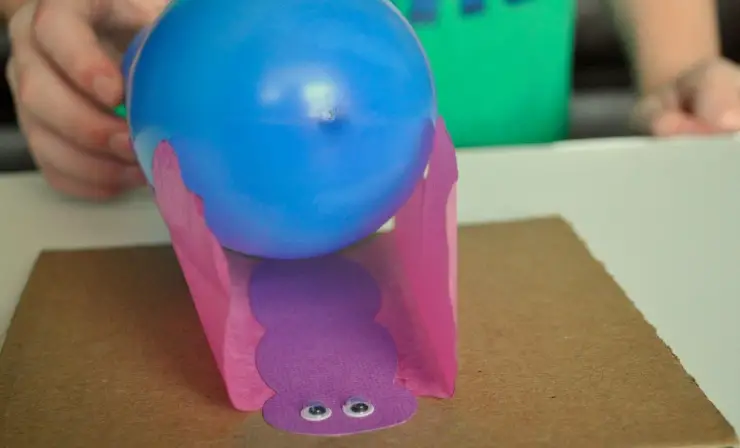
Materials
- A square of cardboard (any size)
- Tissue paper
- Cardstock (or additional cardboard for coloring)
- Googly eyes (optional for a cute touch)
- Glue
Steps
- Begin by cutting a square from your cardboard. The size can vary based on what you have available or prefer.
- Shape the tissue paper into a butterfly, ensuring it consists of two connected wings that fit on the cardboard square but are large enough to flap freely.
- Fashion the butterfly’s body from cardstock or cardboard and cut it out.
- Arrange the tissue wings on the cardboard square without using glue, allowing them to move freely.
- Glue the butterfly’s body onto the tissue wings, applying glue only at the top and bottom of the body to avoid adhering the wings to the cardboard.
- Add googly eyes to your butterfly for an extra bit of personality.
- For optimal movement, consider decorating the tissue wings after the experiment.
- Generate a static charge by rubbing a balloon against hair or clothing.
- Slowly bring the charged balloon close to the butterfly. The static electricity will cause the tissue wings to flutter, simulating the butterfly’s flight.
For a captivating demonstration of how to bring the Butterfly Experiment to life, watching this video is highly recommended.
What It Teaches
This experiment introduces the fascinating world of static electricity and its ability to move objects without direct contact. Children learn about the properties of materials that allow them to be influenced by electrostatic forces, illustrating a fundamental principle of physics in a visually engaging way.
Conceptual Background
This Butterfly Experiment demonstrates how even the simplest materials can be brought to life with a bit of scientific knowledge. It provides an easy-to-understand example of how electrostatic charges attract lightweight objects, mimicking the natural fluttering of a butterfly. Through this experiment, children can grasp the concept of static electricity in a memorable and enjoyable manner, fostering a deeper interest in science and the world around them.
7. Homopolar Motor
This experiment demonstrates the creation of a homopolar motor, showcasing the interaction between a magnetic field and electric current to produce motion. It offers a simple yet profound example of how electromagnetism can be harnessed for motion.
Difficulty Level: Low
Cost: Low ($1 to $5)
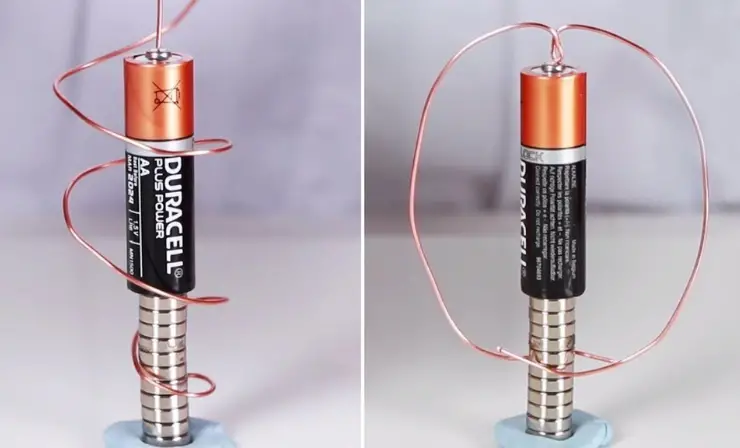
Materials
- A strong magnet
- A battery
- Copper wire
- A small conductive wheel or disk
Steps
- Attach the magnet to one end of the battery.
- Bend the copper wire into a shape that will allow it to touch the magnet and the other end of the battery simultaneously.
- Place the small wheel or disk on the wire to complete the motor.
- Observe how the motor spins when the circuit is completed, creating a simple yet effective demonstration of electromagnetic forces.
- Try different wire shapes and sizes to explore how they affect the motor’s speed and efficiency.
To see a step-by-step guide on creating a Homopolar Motor and understanding the principles behind its motion, it is highly recommended to watch this video.
What It Teaches
Participants will understand the basics of electromagnetism, including how electric current and magnetic fields interact. The experiment introduces the concept of a homopolar motor, demonstrating one of the simplest forms of electric motors. Learners will explore the principles of magnetic fields and their effects on conductive materials.
Conceptual Background
A homopolar motor is the simplest kind of electric motor and demonstrates the direct conversion of electrical energy into mechanical motion. It operates on the principle that a magnetic field exerts a force on a moving charge. In this case, a current-carrying wire is placed in a magnetic field created by a magnet attached to a battery. The interaction between the magnetic field and the electric current generates a force that causes the wire (or a disk or other object) to spin.
8. Electric Cornstarch
Discover the fascinating world of static electricity with this simple yet captivating experiment. Using just a few kitchen items and a balloon, witness the curious behavior of a cornstarch and oil mixture as it reacts to electrostatic charges.
Difficulty Level: Low
Cost: Low ($1 to $5)
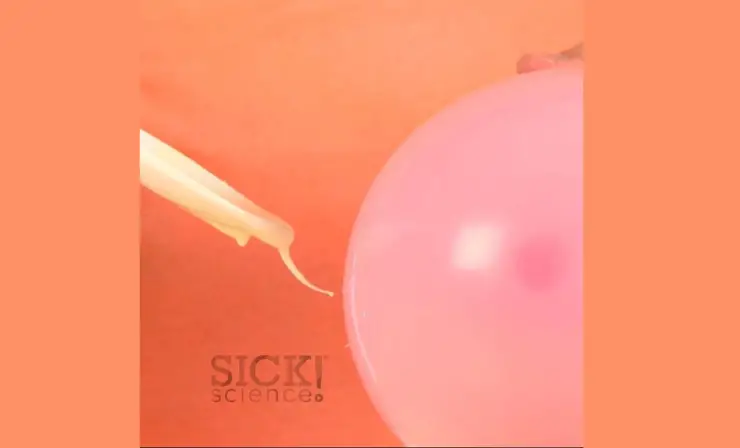
Materials
- Cornstarch
- Vegetable oil
- Mixing bowl
- Large spoon
- Balloon
- Measuring cup
Steps
- Pour 1/4 cup of cornstarch into a mixing bowl.
- Add 1/4 cup of vegetable oil to the bowl and stir the mixture until it thickens.
- Inflate a balloon and securely tie it off.
- Charge the balloon statically by rubbing it against your hair, shirt, or rug, with hair being the preferred method.
- Hold the charged balloon near a spoonful of the cornstarch mixture. Observe as the cornstarch leaps towards the balloon, then slowly move the balloon away.
To learn how to conduct the Electric Cornstarch experiment, watching this demonstration video is highly recommended.
What It Teaches
Witness firsthand how a negatively charged object can attract a neutrally charged one. This experiment is a playful exploration of electrostatic forces, demonstrating the interactions between charged and neutral objects without the need for complex equipment or dangerous materials.
Conceptual Background
This experiment sheds light on the principles of static electricity through an interactive and visually engaging demonstration. When the balloon is rubbed against a surface, it picks up extra electrons, giving it a negative charge. This charge has the power to attract neutral objects, like the cornstarch mixture, because of the attraction between the negative charge of the balloon and the positive parts of the molecules in the cornstarch mixture.
9. Simple Lemon Battery
The Paper Circuits experiment introduces the fascinating world of electronics by allowing kids to create their own functioning circuits on a piece of paper. Utilizing conductive materials and simple components, this activity bridges the gap between creative arts and science, demonstrating the basics of how electrical circuits are designed and how they function to power devices.
Difficulty Level: Low
Cost: Low ($1 to $5)
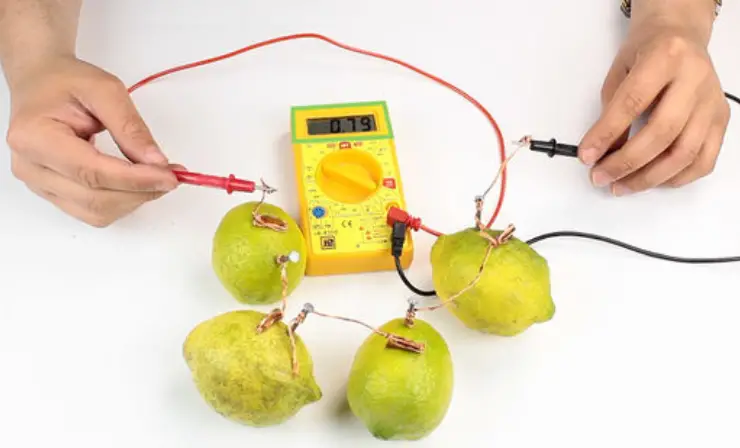
Materials
- A lemon
- Two different types of metal nails (e.g., copper and zinc)
- Alligator clips
- A small LED or voltmeter
Steps
- Insert one copper nail and one zinc nail into the lemon, ensuring they do not touch.
- Connect one alligator clip to the copper nail and the other end to the LED or voltmeter.
- Attach another alligator clip to the zinc nail and connect it to the other terminal of the LED or voltmeter.
- Observe the LED lighting up or the voltmeter indicating the presence of electrical current.
- Discuss the chemical reaction occurring in the lemon battery and its implications for understanding how batteries work.
For an engaging demonstration on how to create a Simple Lemon Battery and understand the science behind turning a lemon into a power source, watching this video is highly recommended.
What It Teaches
This experiment introduces the concept of electrochemical cells, demonstrating how a chemical reaction can produce electrical energy. Participants learn about the flow of electrons from one material to another, generating an electric current. It provides a hands-on approach to understanding the basic principles behind batteries and electrical circuits.
Conceptual Background
The lemon battery experiment illustrates a basic chemical reaction that generates electrical energy. Lemons contain citric acid, which reacts with two different metals (zinc and copper, for example) inserted into the lemon. This reaction creates a difference in electrical potential between the two metals, allowing an electric current to flow when they are connected by a conductor (like an alligator clip).
This setup forms a simple battery, teaching the basics of electrochemistry and how chemical energy is converted into electrical energy.
10. Index Card Flashlight
This experiment illuminates the principles of how electricity can generate light, using simple materials to create a rudimentary flashlight. It demonstrates the transformation of electrical energy into light energy, showcasing the fundamentals of an electrical circuit.
Difficulty Level: Middle
Cost: Low ($1 to $5)
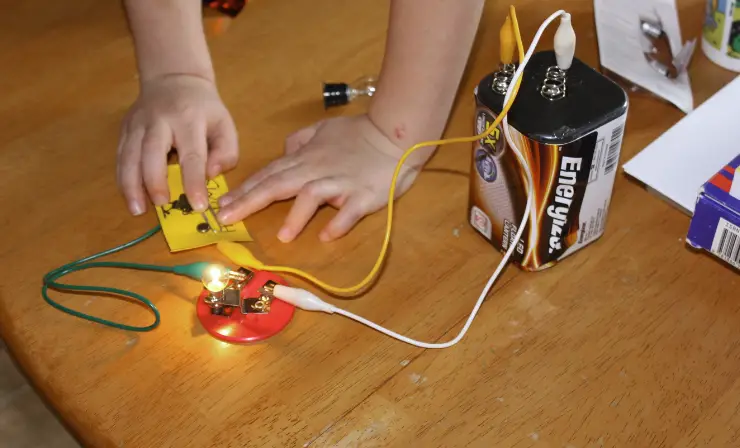
Materials
- Aluminum foil
- An index card
- A small light bulb
- Tape
- Batteries
Steps
- Cut two strips of aluminum foil and tape one end of each to the bottom of the light bulb.
- Attach the other ends of the foil strips to each side of a battery with tape, ensuring they do not touch.
- Use the index card as a switch by placing it between the foil strips to break the circuit.
- Remove the index card to close the circuit and light the bulb, demonstrating a simple electrical circuit.
To see how kids can easily light up a small bulb with just aluminum foil, a battery, and an index card, viewing the demonstration video is recommended.
What It Teaches
Learners are introduced to the basic components of an electrical circuit, including conductors, insulators, and switches, and how electricity flows through a circuit to produce light. It emphasizes the importance of a complete circuit for the flow of electrical energy and provides a hands-on approach to understanding how light bulbs work.
Conceptual Background
This experiment introduces the basic components and principles of an electrical circuit, including energy sources (batteries), conductors (aluminum foil), and loads (a light bulb). When the circuit is completed, electrons flow from the battery through the foil and light bulb, causing the bulb to illuminate. This demonstrates how electrical energy can be converted into light energy, the principle behind all-electric lighting.
11. Potato Clock
This experiment explores how chemical reactions in everyday items like potatoes can be used to generate electricity, powering a digital clock. It illustrates the concept of bio-energy and the potential of alternative energy sources.
Difficulty Level: Middle
Cost: Low ($1 to $5)
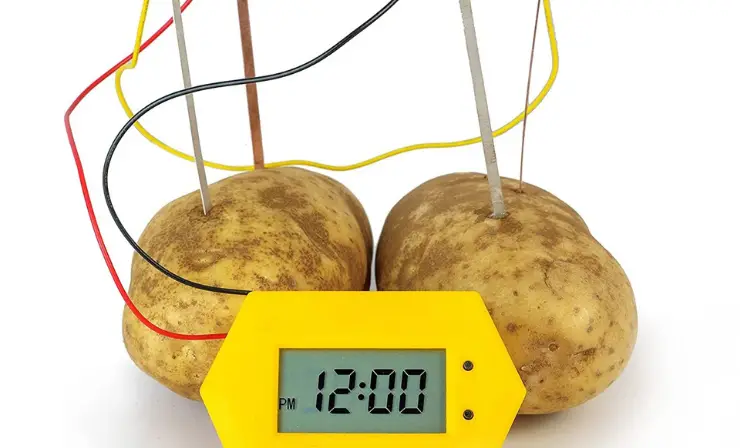
Materials
- Two potatoes
- Copper and zinc strips (or a copper coin and a galvanized nail)
- Alligator clip wires
- A low-voltage digital clock
Steps
- Insert a copper and a zinc strip into each potato.
- Connect the copper strip of the first potato to the clock’s positive terminal using an alligator clip.
- Link the zinc strip of the second potato to the negative terminal of the clock.
- Use another alligator clip to connect the zinc strip in the first potato to the copper strip in the second potato, completing the circuit.
- Watch as the chemical reaction within the potatoes generates enough electricity to power the clock.
Viewing the demonstration video is recommended to witness a potato transform into a power source for a digital clock, proving it’s not just for dinner but a battery too!
What It Teaches
It introduces the principles of chemical energy conversion into electrical energy, demonstrating the operation of a basic electrochemical cell. Participants learn about the electrochemical processes that allow ions to move between electrodes, generating electricity. This experiment encourages thinking about sustainable energy sources and the role of chemistry in electrical engineering.
Conceptual Background
A potato clock works on the principle of converting chemical energy into electrical energy, using the potato as an electrolyte. The metals inserted into the potato (typically zinc and copper) act as electrodes. Chemical reactions between the potato juice and the metals create an electrical flow, turning the potato into a battery. This experiment provides a basic introduction to electrochemistry and how batteries work.
12. Water & Electricity
This experiment investigates the conductivity of water by comparing the electrical properties of salt water and vinegar. It aims to demonstrate how different solutions conduct electricity and the role of electrolytes in this process.
Difficulty Level: Middle
Cost: Low ($1 to $5)
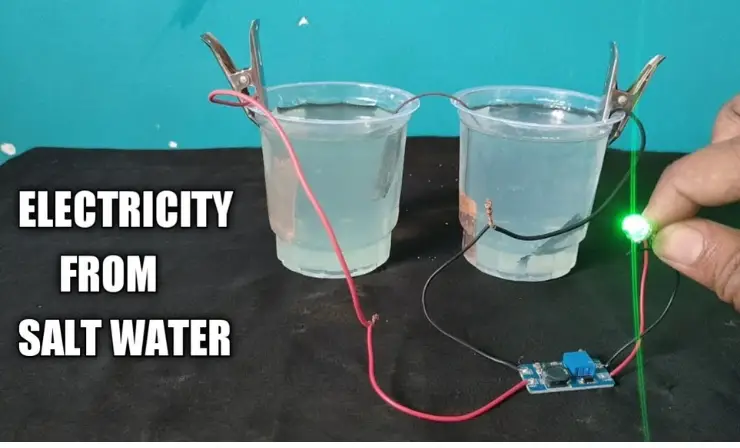
Materials
- A clear glass bottle
- Saltwater solution
- Vinegar
- A voltmeter
- Two electrodes
Steps
- Fill the clear glass bottle with salt water.
- Place two electrodes into the saltwater solution without them touching.
- Use the voltmeter to measure the conductivity of the saltwater by connecting its leads to the electrodes.
- Repeat the process with vinegar in a new glass bottle.
- Compare the electrical conductivity of the saltwater and vinegar, discussing the effects of different electrolytes on the solution’s ability to conduct electricity.
For a detailed demonstration of conducting the Water & Electricity experiment and understanding the principles of conductivity, viewing this video is highly recommended.
What It Teaches
Participants learn about the concept of electrolytes and their importance in conducting electricity through solutions. The experiment provides a clear understanding of how the presence of ions in a solution enables it to conduct electrical current. It also introduces the use of a voltmeter to measure electrical conductivity, offering a practical insight into the basic principles of chemistry and physics.
Conceptual Background
Water’s ability to conduct electricity is well-known, but it’s the impurities (like salts and acids) dissolved in water that actually carry the charge. Pure water is a poor conductor of electricity. When salt (sodium chloride) is dissolved in water, it dissociates into ions (sodium and chloride), which are free to move and carry electrical current. Vinegar, being an acid, dissociates into hydrogen ions and acetate ions, also making it a conductor.
13. Create a Motor
Create a simple motor, demonstrating the interaction between electricity and magnetism to produce motion. It offers a hands-on approach to understanding how electrical energy can be converted into mechanical energy.
Difficulty Level: Middle
Cost: Middle ($5 to $10)
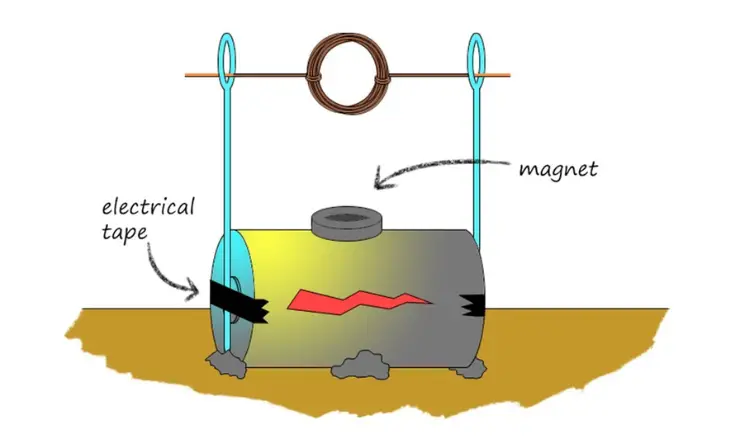
Materials
- Copper wire
- A battery
- Magnets
- Different coil sizes
- Paper clips
- Tape
Steps
- Wrap the copper wire around a battery to create a coil, leaving the ends of the wire-free.
- Attach the ends of the coil to the battery terminals using tape, ensuring they make good contact.
- Place the magnets near the coil without touching it.
- Observe how the coil begins to spin when the circuit is completed, creating a simple motor.
- Try different coil sizes, shapes, and magnet placements to explore the motor’s efficiency and performance.
For a detailed guide on conducting the Creation of a Motor experiment and witnessing the fascinating process in action, watching this video is highly recommended.
What It Teaches
Participants learn about the basic components required to build a motor, including magnets, wires, and a power source. The experiment explains the principles of electromagnetic induction and how a magnetic field can induce motion in a conductor. This activity provides foundational knowledge of how motors work, encouraging further exploration into electromechanical systems.
Conceptual Background
This experiment explores the interaction between electricity and magnetism, foundational to the operation of electric motors. When electric current flows through a wire, it generates a magnetic field around the wire. If this wire is placed near a permanent magnet, the magnetic field created by the electric current interacts with the magnetic field of the magnet, causing the wire to spin. This principle, known as the Lorentz force, is crucial for the functioning of all electric motors.
14. Build a Power Pack
The Build a Power Pack experiment offers a fun and straightforward introduction to constructing primary electrical circuits. It demonstrates how electricity and magnetism can work together to create motion, providing a practical understanding of circuitry.
Difficulty Level: Middle
Cost: Middle ($5 to $10)
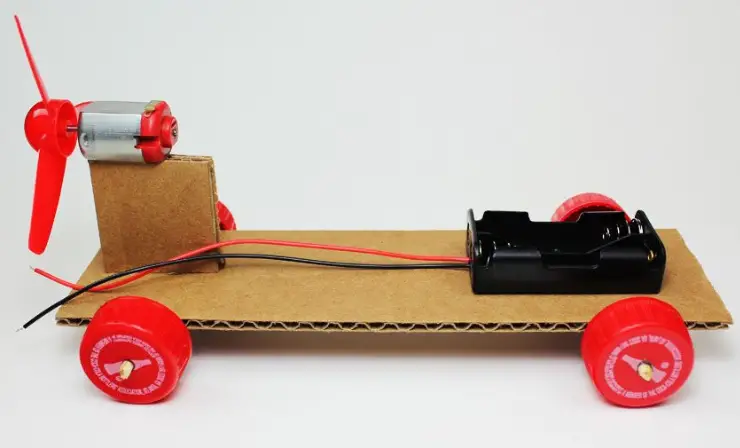
Materials
- Paper clips
- Aluminum foil
- Tape
- Battery
- Small motor
Steps
- Create a switch by folding a piece of aluminum foil and attaching it to the paper clip with tape.
- Connect one end of the paper clip to the positive terminal of the battery and the other end to the motor.
- Complete the circuit by connecting the motor’s other terminal to the battery’s negative terminal.
- Use the aluminum foil switch to control the flow of electricity, powering the motor on and off.
- Observe how the simple circuit can drive motion in the motor, demonstrating the basics of power pack construction.
Viewing this video is recommended to explore a variation on how to conduct the Build a Power Pack experiment and understand the intricacies of assembling a functional power source.
What It Teaches
This experiment teaches the basics of electrical circuits, including the concepts of conductors, insulators, and switches. Participants learn how to assemble a simple circuit that can power a device, reinforcing the principles of how electricity flows through a circuit and the role of magnets in generating motion.
Conceptual Background
Building a power pack involves creating a simple electrical circuit that can store and release energy. This experiment touches on the principles of energy storage, circuit design, and conductivity. Conductive materials allow electrons to flow freely, essential for the movement of electrical energy in a circuit. By assembling a power pack, learners can explore how batteries can be connected to other components to power various devices, demonstrating basic principles of electrical engineering.
15. Making a Dimmer Switch
This experiment explores the concept of controlling electrical flow using a dimmer switch, demonstrating how varying the electrical input can affect light intensity. It offers a practical understanding of basic electronics and circuit design.
Difficulty Level: Middle
Cost: Middle ($5 to $10)
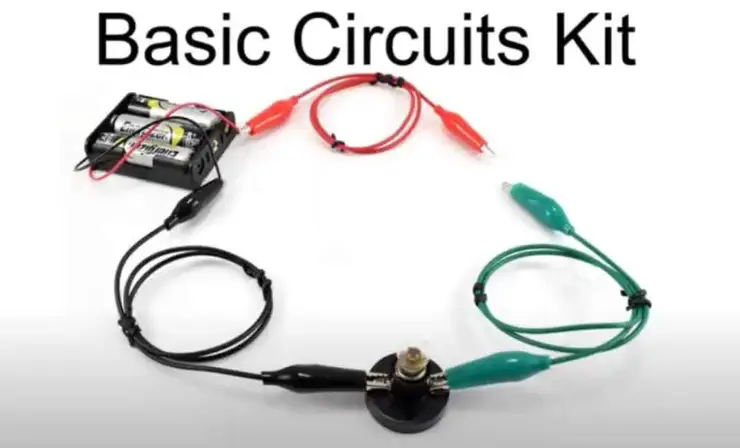
Materials
- A light bulb
- A variable resistor (potentiometer)
- Wire
- A battery
- A breadboard (optional for easier assembly)
Steps
- Connect the light bulb to one terminal of the battery using a wire.
- Insert the variable resistor between the light bulb and the battery’s other terminal.
- Adjust the variable resistor and observe how the light intensity changes.
- Try different resistor values to explore how they affect the brightness of the light bulb, demonstrating the operation of a dimmer switch.
- Discuss the principles behind the experiment, including how resistance controls the amount of current flowing through the circuit.
For an insightful demonstration of how to construct a Dimmer Switch and explore its functionality, viewing this video is highly recommended.
What It Teaches
Learners will understand how resistance affects the flow of electricity in a circuit and how this principle is used to control devices like lights. The experiment introduces the concept of variable resistance and how it can be applied to create a dimmer switch. This activity serves as a foundation for exploring more complex electronic circuits and the role of components like resistors and capacitors.
Conceptual Background
This experiment involves understanding resistance and its effect on the flow of electricity. A dimmer switch works by varying the resistance in an electrical circuit, thereby controlling the intensity of the light bulb. Increasing the resistance reduces the flow of current, dimming the light, and vice versa. This principle demonstrates how electrical resistance can control the amount of energy that flows through a circuit, a fundamental concept in electronics.
16. Paper Circuits
The Copper Plate Coin experiment is an engaging and educational activity that introduces children to the basics of electrical circuits using simple materials and a bit of creativity. By completing a circuit with a copper plate and a coin, participants can light up LEDs, offering a visually striking demonstration of how electricity flows through a circuit.
Difficulty Level: Middle
Cost: Middle ($5 to $10)
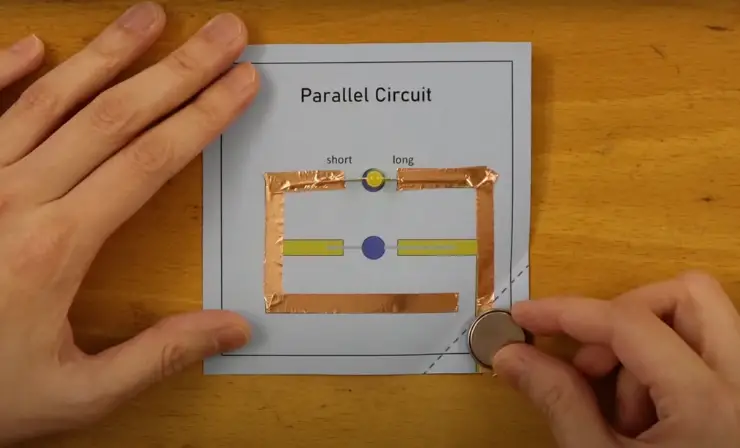
Materials
- Conductive copper tape
- LED lights
- Coin cell battery (e.g., CR2032)
- Paper (construction paper or cardstock works well)
- Tape (clear tape or masking tape)
Steps
- Lay out your piece of paper and plan the design of your circuit, marking where the LED and battery will be placed.
- Apply the conductive copper tape along your drawn lines, ensuring you create a continuous path for electricity to flow. Make sure the circuit connects the LED’s positive and negative leads correctly to the corresponding sides of the battery.
- Insert the LED into the circuit by sticking its legs through the paper and bending them to touch the copper tape. Secure it with tape if necessary.
- Place the coin cell battery in its designated spot, ensuring the positive side is facing up. Secure it with a small piece of tape.
- Complete the circuit by connecting the end of the copper tape to the battery. Your LED should light up if the circuit is correctly assembled.
- Try different circuit designs or add more LEDs to create complex and creative paper circuits.
To learn how to create your own Paper Circuits and see the fascinating combination of creativity and electronics in action, watching this demonstration video is highly recommended.
What It Teaches
This experiment demystifies the workings of electrical circuits, emphasizing the importance of a complete path for electrical flow and introducing the concept of conductivity. Participants learn the basic principles of circuit design, including how to connect components like LEDs and batteries to create a functioning circuit. It offers a creative and hands-on approach to understanding electricity and electronics, fostering skills in problem-solving and design.
Conceptual Background
Paper Circuits simplify the complex world of electronics, making it accessible and understandable for learners of all ages. By creating a circuit on paper, participants see firsthand how electrical components work together to create light, sound, or motion. The use of conductive tape instead of wires introduces the concept of electrical conductivity in a tangible way, showing that electricity can flow through various materials to connect electronic components.
This experiment provides a foundational understanding of how circuits are built and operated, serving as a stepping stone to more advanced electronics projects.
17. Play-Dough Circuits
The Play-Dough Circuits experiment offers a fun and interactive way to understand electrical circuits. Using play dough and a few simple components, it demonstrates how circuits are created and how electricity flows through conductive materials.
Difficulty Level: Middle
Cost: Middle ($5 to $10)
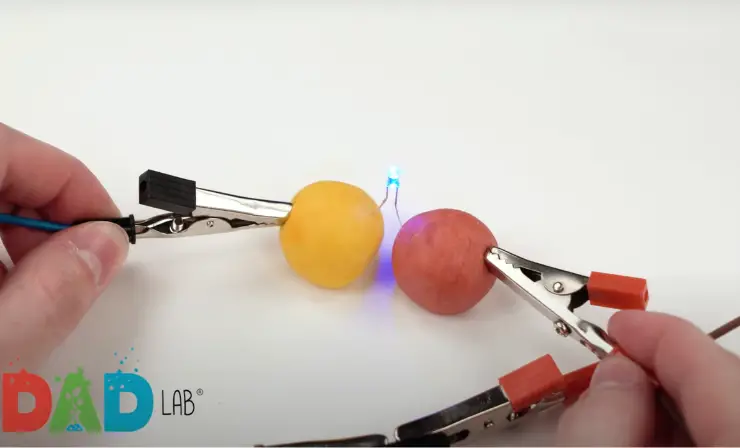
Materials
- Conductive play dough (homemade or store-bought)
- Insulating play dough or material
- LED lights
- Battery pack with wires
- Conductive rods (optional)
Steps
- Mold the conductive play dough into two separate shapes.
- Connect the battery pack to each shape using wires, ensuring the circuit is not completed.
- Insert an LED light into the play dough, bridging the two shapes to complete the circuit.
- Observe the LED light up as the electrical current flows through the conductive play dough.
- Try adding insulating materials between the conductive play dough to understand the role of insulators in circuits.
To discover how to bring electrical concepts to life with Play-Dough Circuits, including setting up your own conductive and insulating paths, watching this instructional video is highly recommended.
What It Teaches
Participants will explore the basics of circuitry, including the concepts of electrical conductors and insulators. The experiment makes it easy to visualize the path of electrical current and introduces the idea of creating simple circuits with everyday materials. It encourages experimentation with different circuit configurations and provides a foundation for learning about electrical engineering principles.
Conceptual Background
Play Dough Circuits use the conductive and insulating properties of different types of play dough to teach about electrical circuits. Conductive play dough contains salt, allowing it to conduct electricity, while insulating dough does not, preventing electrical flow. By creating circuits with these materials, children learn about the flow of electricity, how circuits work, and the importance of conductors and insulators in controlling electrical energy.
18. Build an Electromagnetic Train
The experiment explores the principles of electromagnetism to create a miniature train. It demonstrates how electromagnetic forces can be used to propel objects forward, providing a hands-on way to investigate magnetic fields and electrical currents.
Difficulty Level: High
Cost: Middle ($5 to $10)
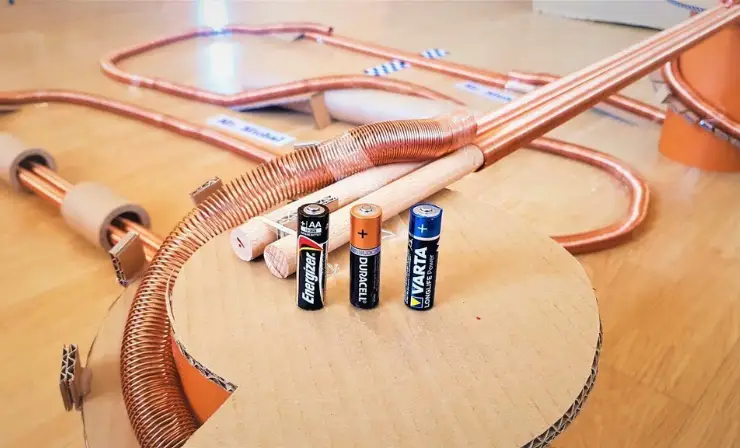
Materials
- Conductive track (e.g., coiled copper wire)
- Battery
- Strong magnets
- A small vehicle or carriage that fits on the track
Steps
- Construct the track using the conductive material, ensuring it is smooth and even.
- Attach the magnets to either end of the battery.
- Place the battery and magnet assembly onto the track.
- Observe how the assembly moves along the track, propelled by the electromagnetic forces generated.
- Discuss the principles of electromagnetic propulsion and its applications in modern technology.
For an insightful demonstration of how to construct a simple version of an Electromagnetic Train and grasp the science that propels it, watching this video is highly recommended.
What It Teaches
Through building an electromagnetic train, learners gain insights into the workings of electromagnetic propulsion and the basic principles underlying modern electric trains. The experiment encourages exploration of how electricity and magnetism interact to create motion, offering a practical understanding of electromagnetism.
Conceptual Background
This experiment delves into electromagnetism, a branch of physics involving the study of electric currents and magnetic fields. The electromagnetic train model demonstrates how magnetic fields can be used to propel objects without physical contact. By creating a coil (track) that carries current, a magnetic field is generated. Placing a battery-powered assembly with magnets on the coil interacts with this magnetic field, propelling the assembly along the coil.
This principle underlies the technology behind real-world magnetic levitation (maglev) trains, which use electromagnetic propulsion to move vehicles at high speeds with minimal friction.
19. Bottle Radio
This experiment demonstrates how to create a basic radio receiver using aluminum foil, showcasing the principles of radio communication and the science of sound.
Difficulty Level: High
Cost: High ($10 to $20)
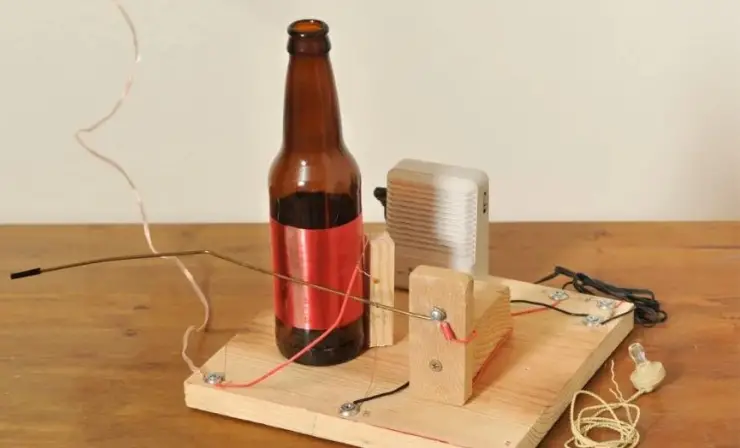
Materials
- A plastic or glass bottle
- Aluminum foil
- Wire
- Earphones
- A radio tuner circuit (simple kits available)
Steps
- Wrap the plastic bottle with aluminum foil, creating a conductive surface.
- Connect the wire to the aluminum foil and attach the other end to the radio tuner circuit.
- Connect the earphones to the circuit.
- Tune the circuit to different frequencies and listen through the earphones.
- Explore different stations and sounds, understanding how radio signals are received and heard through the makeshift bottle radio.
To learn how to create your own Bottle Radio and understand the principles behind it, watching this demonstration video is highly recommended.
What It Teaches
Participants learn about the fundamentals of radio waves and how they can be captured and converted into sound. The experiment provides an introduction to the electromagnetic spectrum and the concept of frequency modulation. It encourages exploration into the physics of sound and the technology behind radio transmission and reception.
Conceptual Background
A bottle radio simplifies the concept of radio reception, where electromagnetic waves (radio waves) are converted into sounds. The aluminum foil acts as an antenna, capturing radio waves. The simple circuit within the bottle, connected to a tuner and speaker or earphones, decodes these waves into electrical signals that the earphones convert into sound. This experiment introduces the electromagnetic spectrum and the basic principles of radio communication.
The Value of Electricity Science Experiments for Kids
Electricity science experiments for kids offer a treasure trove of educational benefits that extend far beyond the classroom, making them an invaluable addition to any science curriculum or at-home learning experience. These hands-on activities provide a unique opportunity to engage young minds in the exploration of fundamental scientific principles, fostering a deeper understanding of the world around them.
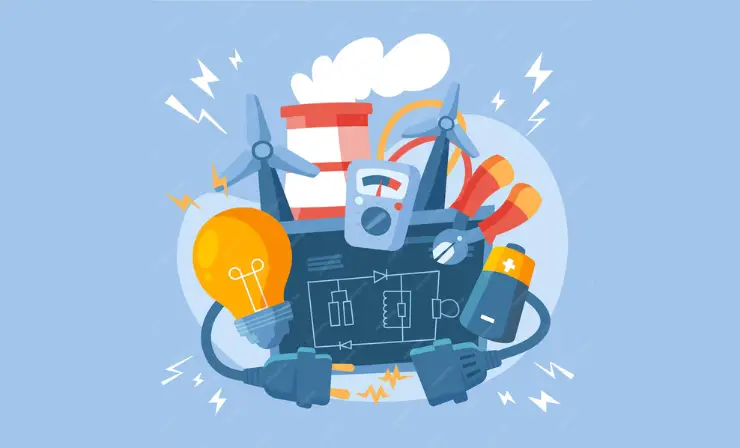
Here’s why incorporating such experiments into children’s education is profoundly beneficial:
- Stimulates Curiosity and Engagement: Electricity is a fascinating subject for children, filled with wonders and the potential for discovery. Experiments turn abstract concepts into tangible experiences, sparking curiosity and encouraging kids to ask questions, seek answers, and delve deeper into scientific inquiry. This active engagement helps cement understanding and retention of complex ideas.
- Builds Critical Thinking Skills: By experimenting with electrical circuits, conductive materials, and the principles of electromagnetism, children learn to hypothesize, test, observe, and draw conclusions. These activities promote critical thinking and problem-solving skills, as kids must navigate challenges, troubleshoot issues, and refine their approaches based on experimental outcomes.
- Enhances STEM Education: Science, Technology, Engineering, and Mathematics (STEM) education is crucial in today’s technology-driven world. Electricity experiments provide a practical foundation in physics and engineering principles, encouraging an early interest in STEM fields. This hands-on learning can inspire future careers and foster a generation equipped to tackle the technological challenges of tomorrow. Explore our informative article on STEM activities, “19 Best STEM Activities for Elementary Students: Engaging and Educational Projects” for more insights.
- Encourages Creativity and Innovation: Electricity experiments often require children to use common household items or simple materials to explore complex concepts. This limitation becomes a strength, pushing kids to think creatively and innovate with the resources at hand. Such creativity in problem-solving and design is a valuable skill in all areas of life and work.
- Promotes Collaboration and Communication: Many electricity experiments are best conducted in pairs or small groups, providing an excellent opportunity for collaborative learning. Working together, children learn to communicate ideas, share tasks, and support each other’s learning. This collaborative process is essential for developing social skills and the ability to work effectively in teams. To delve deeper into the topic of Collaboration and Communication, consider reading “17 Engaging SEL Activities for Middle School Students: Building Emotional Intelligence in 2023 Classroom” for comprehensive insights.
- Demonstrates Real-World Applications: Electricity is everywhere, powering homes, schools, and nearly every aspect of modern life. Through experiments, children see firsthand how its principles are applied in the real world, from the gadgets they use to the way cities are powered. This relevance to their daily lives helps children appreciate the importance of science and technology, encouraging them to become informed and conscientious citizens.
- Fosters a Love for Learning: Perhaps most importantly, these science experiments make learning fun. The excitement of lighting up an LED, powering a clock with a potato, or creating a simple motor can turn even the most reluctant learners into enthusiastic scientists. This positive association with learning fosters a lifelong love for discovery and education.
In conclusion, the benefits of integrating electricity science experiments for kids into education are vast and varied. By offering hands-on, engaging, and intellectually stimulating activities, these experiments help cultivate curious, critical-thinking, and creative young minds ready to explore the electrifying world of science.
Questions For Further Exploration

As we transition from hands-on experimentation to reflective inquiry, our “Questions for Further Exploration” section serves as a bridge to deeper understanding and curiosity. Here, young scientists are invited to ponder and investigate beyond the surface, challenging them to extend their learning and apply critical thinking.
This segment aims to cultivate a spirit of discovery, prompting learners to question, adapt, and innovate with the scientific principles they’ve encountered, ensuring their journey of exploration continues well beyond the experiments themselves.
| Experiment | Questions |
|---|---|
| 1. Bending Water with Static Electricity |
|
| 2. Make a Magic Wand |
|
| 3. Bubble Balloons |
|
| 4. Soda Can Electroscope |
|
| 5. Separate Salt & Pepper |
|
| 6. Butterfly Experiment |
|
| 7. Homopolar Motor |
|
| 8. Electric Cornstarch |
|
| 9. Simple Lemon Battery |
|
| 10. Index Card Flashlight Experiment |
|
| 11. Potato Clock |
|
| 12. Water & Electricity |
|
| 13. Create a Motor |
|
| 14. Build a Power Pack |
|
| 15. Making a Dimmer Switch |
|
| 16. Paper Circuits |
|
| 17. Play Dough Circuits |
|
| 18. Build an Electromagnetic Train |
|
| 19. Bottle Radio |
|
Useful Resources
- What Is Electricity? Worksheets And Science Activity Ideas For Kids
- Science Games and Videos
- How to Teach Kids About Electricity (Activities and Experiments)
Final Thoughts
Through these hands-on experiments, children gain invaluable skills and knowledge, setting the foundation for a lifetime of curiosity and discovery. This article serves as a testament to the power of engaging young minds with the wonders of electricity, ensuring they are equipped, inspired, and ready to light up the future with their ideas and innovations.
For more exciting educational content for school students across various subjects, take a look at our article, “Empower Your Students with the 13 Best Online Coding Classes for Middle Schoolers.”
- Overview of 22 Low-Code Agencies for MVP, Web, or Mobile App Development - October 23, 2024
- Tips to Inspire Your Young Child to Pursue a Career in Nursing - July 24, 2024
- How Parents Can Advocate for Their Children’s Journey into Forensic Nursing - July 24, 2024
